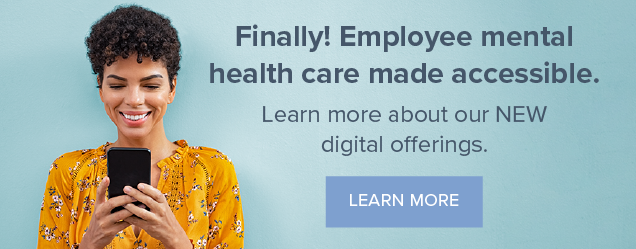
When it comes to employee engagement, satisfaction, and productivity, mental health is clearly a huge factor. Addressing issues such as depression and anxiety among employees has finally come to the forefront for many organizations that want to support their employees, however, there are still barriers to getting the care they need.
In fact, a mere 43% of adults with mental illness get treatment in a given year. The need for mental health support is higher than ever before, but people still face multitudes of obstacles when it comes to the stigma and access.
The National Alliance on Mental Health reports in an infographic that the average delay between the onset of mental health symptoms and treatment is 11 years.
Something is clearly preventing people from getting the help they need.
Unfortunately, a host of intersecting factors stand between people and adequate mental health care. A 2018 study polled people who had been diagnosed with depression but who didn’t seek treatment. This group cited reasons such as:
- “Couldn’t afford cost” (47.7%)
- “Thought I could handle it without treatment” (22.2%)
- “Didn’t know where to go for service” (16.7%)
- “Didn’t have time/too busy” (14.2%)
- “Concerned about opinion of neighbors” (11%)
- “Concern about effect on job” (8.1 %)
- “Didn’t want others to find out” (6.5%)
- “Had no transportation or treatment too far” (5.8%)
Some factors in this list speak to a lack of access: Mental health care is too far away, too costly, or requires jumping through confusing insurance hoops. Other factors speak to the stigma around mental health that still exists. People are hesitant to seek help for mental health issues because they fear others may view or treat them negatively as a result.
As an employer, you can help your employees surmount these barriers by providing mental health resources that are easier to access and more discreet than traditional treatment methods.
The State of Employee Mental Health Today
Mental health struggles are prevalent in the workforce. Depression, anxiety, addiction, and other issues are also closely tied to workplace stress. The more stressed your employees are, the more likely they are to experience negative effects on their mental health. And these are extremely stressful times.
As stress and mental health challenges accumulate, employees can experience burnout. Burnout isn’t just the fatigue we all feel from time to time. Burnout refers to a chronic state of stress that results in overall exhaustion, frustration, and a defeatist attitude that can cause employees to disengage from their work.
Three out of four people have experienced burnout at some point, while 40% of workers report they’ve experienced burnout specifically during the COVID-19 pandemic.
Most employers are aware of the mental health crisis in America’s workplaces—but many are unsure what to do about it. A recent study by the HR Research Institute, “The State of Mental Health and Stress in the Workplace,” polled 778 human resources professionals on the subject:
- 82% of respondents said stress is common in their organization.
- Only 38% said their organization is good at helping employees address stress.
- Nearly three-quarters of employers said they offered some form of employee mental health benefits.
- Only 11% of those employers said their organization is good at helping employees address mental health issues.
How Can Employers Help? With Technology.
The barriers discussed at the beginning of this article are among the reasons traditional mental health benefits often fail to fully address employee mental health issues. But an emerging group of technology-based solutions help break down these barriers.
Teletherapy
Since the COVID-19 pandemic started, the adoption of telehealth for mental health therapy has skyrocketed. Therapy translates well to the video chat format, experts say, and the research indicates it can be just as effective as in-person therapy.
After the pandemic finally recedes, it is likely many people will prefer the convenience and privacy of continuing to see their mental health providers online. This may lead to more use of mental health services overall, especially by people who had never seen a therapist before.
Text-Based Therapy
Another promising alternative to traditional mental health care is text-based therapy. Text-therapy is growing in popularity, supported by a number of new online services.
Typically, text therapy promises 24/7 access to qualified mental health professionals via mobile apps or websites. Not only is text-based therapy convenient and accessible, but it can be much less intimidating for people who are anxious about opening up over the phone or in person to therapists.
If you’re interested in providing text therapy to your employers, consider WellRight’s new TextCoach™ solution.
Created in partnership with Chicago-based health and wellness company Marquee Health, TextCoach™ is a convenient and stigma-free messaging platform that connects employees with licensed mental health professionals to address stress, anxiety, grief, depression, isolation, or relationship issues. TextCoach™ users can also proactively work on mindfulness, coping skills, or resiliency.
All TextCoach™ communications are encrypted and securely stored. Learn more about TextCoach™ here.
Digital Behavioral Health Solutions
Digital behavioral health apps deliver a form of computerized cognitive behavioral therapy (cCBT). Several cCBT systems exist, but in general, cCBT apps offer participants self-guided treatment for mental health issues via interactive online modules.
A growing body of research suggests that cCBT is both effective and helps remove physical and emotional barriers to accessing mental health services.
WellRight recently introduced Animo, a cCBT app designed to help your employees manage problems like anxiety, depression, and stress in a results-oriented manner.
Also developed with Marquee Health, Animo lets users track their improvement by completing pre- and post-assessments. Dynamic training modules encourage development of practical skills and coping strategies in a dynamic, private environment ideal for those unlikely to seek help elsewhere.
Making it easy for your employees to access mental health care via technological tools creates a win-win situation: Employees who need mental health care can access it easily, inexpensively, and quickly, giving them support whenever it’s needed. The result? Employees are happier, more productive, incur lower healthcare costs … and don’t need to miss an entire afternoon to get across town for their therapy appointments.
As more employers expand their mental health benefits to include innovative solutions such as text-based therapy and digital behavioral health apps, years-long delays in seeking treatment will become things of the past. Barriers to mental health will crumble, and employee mental health will improve.




